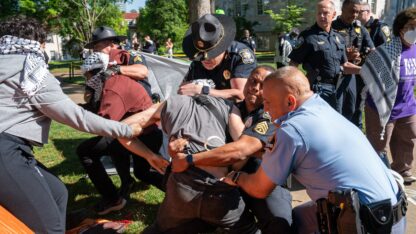Celebrating 25 years of Southern life in the High Museum exhibit ‘Picturing The South’

“Invisible Empire” by Atlanta photographer Sheila Pree Bright is featured in The High’s “Picturing The South” series.
Sheila Pree Bright/The High Museum
“Picturing the South” was a photography series launched by the High Museum in 1996 when Atlanta hosted the Olympics. Featured photographers were invited to photograph the South any way they saw fit, resulting in a diverse array of perspectives. Twenty-five years later, the High presents a commemorative reprisal of the exhibition, bringing back artists from 1996’s show to present photographs the museum has never seen before.
“City Lights” producer Summer Evans spoke with Gregory Harris, the High’s curator of photography, and Sheila Pree Bright, renowned Atlanta photographer, about the exhibit “Picturing the South.”
Interview highlights:
Harris on how the commission invites wide-ranging perspectives on the South:
“It’s very open-ended. The artists are given a lot of creative latitudes to figure out what they want to shoot, how they want to make the pictures. We don’t give them an assignment. The only parameters are that the work has to be made in the region,” said Harris. “Trying to puzzle out ‘What is the South?’ and ‘How are we going to show it?’ is one of the challenges that the artists work out as they’re making the projects.”
“A third of the photographers, overall, are from the South. But many of them are from elsewhere in the U.S., and one of them, Martin Parr, is actually from the U.K.,” said Harris. “Martin Parr, for example, really embraced his status as an outsider and brought a very different kind of sense of humor and criticism to the observations of consumption, the excess of American consumer culture. I don’t know that an American would necessarily have homed in the same way.”
“What the exhibition tries to do, and really, what the photographers have tried to do with their work, is to show how varied and diverse and layered the South is. I think the South is probably one of the more stereotyped and misunderstood parts of the country. It’s something that’s mythologized in films, literature, music, obviously news reports … I think what a lot of the photographers have tried to do is debunk a lot of those myths and really show the depth and complexity of the people who live here.”
Atlanta photographer Sheila Pree Bright’s featured work “Invisible Empire:”
“’Invisible Empire’ explores the tension at Stone Mountain Park and outside of Atlanta. It came about through my experience documenting the Black Lives Matter movement for seven years, from Trayvon Martin to George Floyd and Breonna Taylor,” said Bright. “These police killings had become part of the daily lives of Black folks, so I’ve been thinking about how this psychological trauma had affected the community from slavery, Jim Crow, up until now. So I started researching the myth and reality of the Southern South and critically looking at the roots of white supremacy through the lens of landscape.”
“I felt that taking it off of the body and looking at the land, it was a way for me to amplify the talk about it in a different way, and I think this would be a chance for us — and what I mean by us, the culture of America — to lift the banner of humanity by facing this painful legacy of violence towards Black bodies, breaking this generational trauma through all of us, not just Blacks, but whites too,” Bright said.
On featured photographer Dawoud Bey’s striking composite images:
“The photographs that we have by Dawoud from the commissions are from a series that he did throughout most of the 1990s, where he was working with a very large format Polaroid camera … and he would piece multiple of these images together to make a single portrait,” said Harris. “They show African-American high school students from a high school in East Point where he was working.”
“He gets in close to a person’s face or a part of their body and makes multiple images that he pieces together to form a larger portrait. But the images are somewhat out of alignment; maybe the person’s looking one way in this picture, looking slightly a different way in the next one, so they don’t perfectly line up in the frames. But what he was really interested in, in those images, is how that way of fracturing the image and piecing it back together implies the depth and complexity of the person and how the image can’t really encapsulate the entirety of that person’s being.”
“Picturing the South: 25 Years” is on view through February 6th at the High Museum of Art in Atlanta. More information is available at https://high.org/highlights/picturing-the-south.





